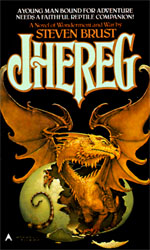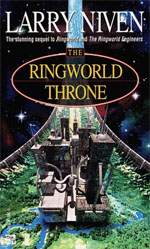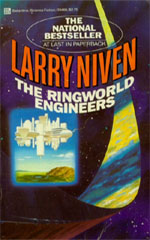 Why didn’t anybody tell me about this?
Why didn’t anybody tell me about this?
Jhereg, the first in a series of books starring the character of Vlad Taltos, was originally published 25 years ago and I’m only finding out about it now?
Not fair.
Truth be told, though, I only have myself to blame. I’ve heard about the Dragaeran books a number of times over the last decade or so, mostly on the rec.arts.sf.written newsgroup, but also as far afield as Penny Arcade. I actually bought Jhereg about four years ago, started it, and bounced off the first chapter.
It should be noted that I didn’t bounce because it was bad. I just bounced because I wasn’t in the mood for that sort of book
Which is ironic, because the book is actually almost nothing like the first chapter.
The first chapter reads like the introduction to a grand saga of sorts — something along the lines of A Game of Thrones or the Malazan Empire books. The rest of the book reads pretty much nothing like that. In fact, if I was going to describe the rest of the book, it would be something like this:
A pulp detective novel by Raymond Chandler, except the main character is an assassin instead of a private detective and his seedy office is in a world of high fantasy instead of the 1940s.
And it really is as awesome as that sounds.
Actually, though, saying “high fantasy” is somewhat misleading because one of the things Steven Brust does very well is blending together high fantasy and low fantasy. Vlad Taltos runs a small-time criminal organization in a gritty fantasy city. But just a short teleport-hop away, Taltos will also find himself rubbing shoulders with powerful Dragonlords who have lived for thousands of years and wield powerful sorceries that can lay waste to mountains.
And it works.
As an example of making things work, Brust’s world is one of the rare instances in which I’ve seen anyone attempt to work with a society where easy, prolific, D&D-style revivification is possible. And he makes that world believable, largely by simply saying, “This is the way things works.” And then building the world logically around it. “Death” in the Dragaeran Empire doesn’t mean what “death” does in the real world, and everyone in the story just seamlessly accepts that reality.
What else can I say about Jhereg?
Perhaps the most notable thing about the book is Brust’s prose. It’s not the type of eloquent or beautiful language that lends itself to loving quotation, but it’s tight and it’s fun to read. It’s really easy to plow through a hundred pages and then find yourself wondering where the last hour disappeared to you. I literally lost myself in the story, which is a rare pleasure.
Long story short: If you haven’t already read it, I highly recommend Jhereg. You might be 25 years late to the party, but it’s a really great party and you won’t be the only one to have just arrived.
GRADE: B
Steven Brust
Published: 1983
Publisher: Ace
Cover Price: $7.99
ISBN: 0441006159
Buy Now!














